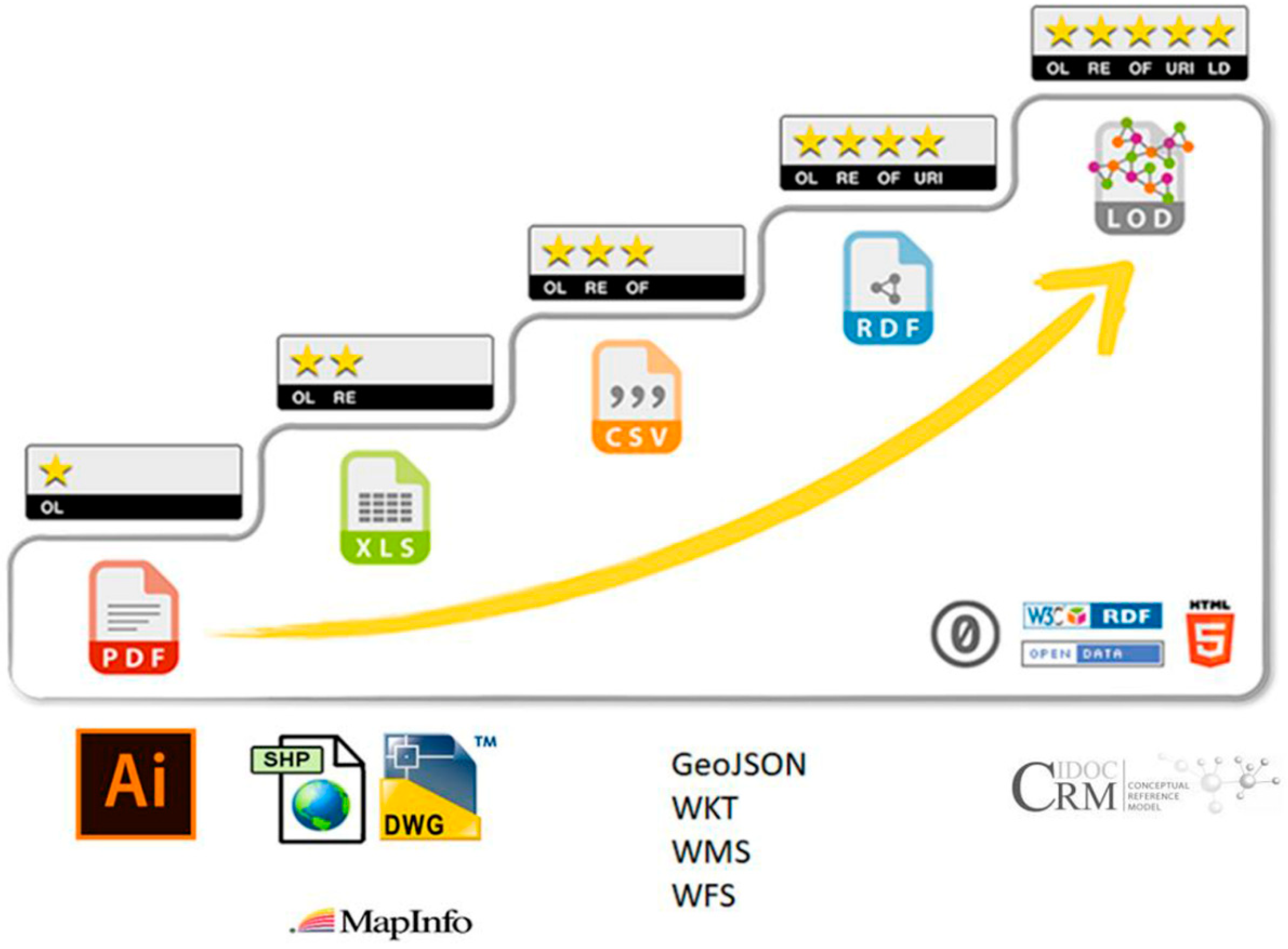One Archaeology: A Manifesto for the Systematic and Effective Use of Mapped Data from Archaeological Fieldwork and Research
Abstract
1. Introduction
2. Background and Context
3. Archaeological Events: Thinking Beyond the Monument
3.1. Organisational Variables in Archaeological Fieldwork
3.2. Reporting Variables in Archaeological Fieldwork
4. Spatial Data and the Technique-Dependent Challenges within Archaeological Fieldwork
4.1. Invasive Techniques
Excavation
4.2. Non-Invasive Techniques
4.2.1. Airborne Mapping
4.2.2. Field Survey
4.2.3. Legacy Surveys and Site Plans
4.2.4. Remote Sensing Techniques
5. The Case for an Archaeological Spatial Data Infrastructure
5.1. Challenges
5.1.1. Data Themes
5.1.2. Framework
5.1.3. Hosting
5.1.4. Licencing
5.1.5. Formats
5.1.6. Data Transfer
5.1.7. Access and Sensitivity
5.1.8. Skills and Raising Awareness
5.1.9. Recording Systems
5.1.10. Vocabularies
5.2. Societal Benefits
5.3. Mandate
5.4. Realising the Potential
- -
- Data should be collected once and maintained at a level where this can be done most effectively (Infrastructure).
- -
- It should be possible to seamlessly combine data from different sources and share it between many users and applications (Interoperability).
- -
- Data should be openly shared so that users can discover which spatial data is available, evaluate its fitness for purpose and understand the conditions for reuse (Findability).
- -
- build capacity within the profession to use and share spatial data;
- -
- ensure that datasets are routinely and promptly updated;
- -
- promote best practice;
- -
- make data discoverable, available as View and Download Services, preferably under an Open Licence. INSPIRE technical specifications already promote good data stewardship, encapsulated by the FAIR Data principles [126,127] for scientific data. In particular, metadata should facilitate interoperability and reuse [128]:
- -
- enable users to discover what the dataset is about. Users should also be able to explore the data to ensure that the data is fit for purpose. Finally, users also need to understand how the data can be used through exploitation metadata [128].
5.4.1. Implementation
5.4.2. Infrastructure Goals and Priorities
5.4.3. Promoting Open Licencing
5.4.4. Findability—The Need for a Spatial Approach
6. Conclusions
Author Contributions
Funding
Conflicts of Interest
References
- Jackson, I. OneGeology: Improving access to geoscience globally. Earthwise 2010, 26, 14–15. Available online: http://nora.nerc.ac.uk/id/eprint/17372 (accessed on 15 February 2020).
- Simons, B.; Raymond, O.; Jackson, I.; Lee, K. OneGeology—Improving global access to geoscience. In Digital Soil Assessments and Beyond, Proceedings of the 5th Global Workshop on Digital Soil Mapping, Sydney, Australia, 10–13 April 2012; CRC Press: Boca Raton, FL, USA, 2012; pp. 265–275. [Google Scholar]
- OneGeology. OneGeology Mission Statement. Available online: http://www.onegeology.org/what_is/mission.html (accessed on 15 February 2020).
- Panek, J.; Netek, R. Collaborative Mapping and Digital Participation: A Tool for Local Empowerment in Developing Countries. Information 2019, 10, 255. [Google Scholar] [CrossRef]
- McKeague, P.; Corns, A.; Shaw, R. Developing a Spatial Data Infrastructure for Archaeological and Built Heritage. Int. J. Spat. Data Infrastruct. Res. 2012, 7, 38–65. Available online: https://ijsdir.sadl.kuleuven.be/index.php/ijsdir/article/view/239 (accessed on 20 February 2020).
- De Kleijn, M.; van Manen, N.; Kolen, J.; Scholten, H. Towards a User-centric SDI Framework for Historical and Heritage European Landscape Research. Int. J. Spat. Data Infrastruct. Res. 2014, 9, 1–35. Available online: https://ijsdir.sadl.kuleuven.be/index.php/ijsdir/article/view/341 (accessed on 15 February 2020).
- Council of Europe. European Convention on the Protection of the Archaeological Heritage (Revised). 1992. Available online: https://www.coe.int/en/web/conventions/full-list/-/conventions/treaty/143 (accessed on 15 February 2020).
- Richards, J.D. Digital Infrastructures for Archaeological Research: A European perspective. The CSA Newsl. 2012, XXV. Available online: http://csanet.org/newsletter/fall12/nlf1202.html (accessed on 15 February 2020).
- Wright, H.; Richards, J.D. Reflections on Collaborative Archaeology and Large-Scale Online Research Infrastructures. J. Field Archaeol. 2018, 43 (suppl. 1), 60–67. [Google Scholar] [CrossRef]
- McKeague, P.; Thomas, D. Evolution of national heritage inventories for Scotland and Wales. J. Cult. Herit. Manag. Sustain. Dev. 2016, 6, 113–127. [Google Scholar] [CrossRef]
- Meylemans, E. Drie jaar Centrale Archeologische Inventaris: Een overzicht en stand van zaken. In Centrale Archeologische Inventaris (CAI)-I, De opbouw van een archeologisch beleidsinstrument, IAP-Rapporten 14 (CAI-I); Meylemans, E., Ed.; Instituut voor het Archeologisch Patrimonium: Brussels, Belgium, 2004; pp. 9–28. Available online: https://oar.onroerenderfgoed.be/item/1 (accessed on 15 February 2020).
- INSPIRE. Data Specifications, Themes. Available online: https://inspire.ec.europa.eu/about-inspire/563 (accessed on 20 February 2020).
- GSDI. Developing Spatial Data Infrastructures: The SDI Cookbook, Version 2; Global Spatial Data Infrastructure; Nebert, E., Ed.; 2004. Available online: http://gsdiassociation.org/images/publications/cookbooks/SDI_Cookbook_GSDI_2004_ver2.pdf (accessed on 15 February 2020).
- INSPIRE Knowledge Base. Data Specifications, Themes. Available online: https://inspire.ec.europa.eu/Themes/Data-Specifications/2892 (accessed on 16 April 2020).
- INSPIRE Thematic Working Group. Protected Sites D2.8.I.9 Data Specification on Protected Sites– Technical Guidelines; version 3.2; 2014. Available online: https://inspire.ec.europa.eu/id/document/tg/ps (accessed on 15 February 2020).
- Scottish Government. Planning Advice Note 2/2011: Planning and archaeology; 2011. Available online: https://www.gov.scot/publications/pan-2-2011-planning-archaeology/ (accessed on 15 February 2020).
- ALGAO. 2016–2017 ALGAO Scotland Infographic; 2017. Available online: https://www.algao.org.uk/sites/default/files/documents/2016-17%20ALGAO%20Scotland%20Infographic.pdf (accessed on 15 February 2020).
- Verband der Landesarchäologen in der Bundesrepublik Deutschland Kommission Archäologie und Informationssysteme—ADeX-Standard. Available online: http://www.landesarchaeologen.de/verband/kommissionen/archaeologie-und-informationssysteme/projektearbeitsgruppen/adex/ (accessed on 24 February 2020).
- Association of State Archaeologists of Germany. Archaeology and Information Systems. Available online: http://www.landesarchaeologen.de/fileadmin/Dokumente/Dokumente_Kommissionen/Dokumente_Archaeologie-Informationssysteme/Dokumente_AIS_ADeX/ADeX-Poster_en.pdf (accessed on 24 February 2020).
- Fernández Freire, C.; Parcero-Oubiña, C.; Uriarte González, A. A Data Model for Cultural Heritage within INSPIRE. Cadernos de Arqueoloxía e Patrimonio (CAPA); (standards, formats and access). 2014. Available online: http://digital.csic.es/handle/10261/94227 (accessed on 15 February 2020).
- Van Daele, K.; Vermeyen, M.; Mortier, S.; Meganck, L. When Data Meets the Enterprise: How Flanders Heritage Agency Turned a Merger of Organisations into a Confluence of Information. In Oceans of Data. Proceedings of the 44th Conference on Computer Applications and Quantitative Methods in Archaeology, Oslo 30 March–3 April 2016; Matsumoto, M., Uleberg, E., Eds.; Archaeopress: Oxford, UK, 2018; pp. 273–283. [Google Scholar]
- Catney, S. So what is an event? SMR News 1998, 7. Available online: https://www.heritagegateway.org.uk/gateway/file/hg/content/upload/her_file_store/4882.pdf (accessed on 15 February 2020).
- exeGesIS Historic Buildings, Sites and Monuments Record (HBSMR). Available online: https://www.esdm.co.uk/hbsmr-historic-environment (accessed on 30 March 2020).
- Arches. Available online: https://www.archesproject.org/ (accessed on 30 March 2020).
- Archwhilio. The Historic Environment records of Wales. Available online: https://www.archwilio.org.uk/arch/ (accessed on 30 March 2020).
- McCoy, M.D. Geospatial Big Data and archaeology: Prospects and problems too great to ignore. J. Archaeol. Sci. 2017, 84, 74–91. [Google Scholar] [CrossRef]
- SEADDA. About SEADDA. Available online: https://www.seadda.eu/?page_id=1274 (accessed on 8 April 2020).
- Archaeology Scotland. Discovery and Excavation in Scotland. Available online: https://archaeologyscotland.org.uk/join-us/discovery-and-excavation-scotland/ (accessed on 15 February 2020).
- Wissen Bildung Gemeinschaft Das archäologische Jahr in Bayern. Bayerisches Landesamt für Denkmalpflege/Gesellschaft für Archäologie in Bayern (ed.). Available online: https://www.wbg-wissenverbindet.de/11429/das-archaeologische-jahr-in-bayern (accessed on 15 April 2020).
- Hardman, C.; Richards, J.D. OASIS Dealing with the Digital Revolution. In The Digital Heritage of Archaeology: CAA 2002. Computer Applications and Quantitative Methods in Archaeology. Proceedings of the 30th CAA Conference, Heraklion, Crete, April 2002; Doerr, M., Sarris, M., Eds.; Archive of Monuments and Publications, Hellenic Ministry of Culture: Heraklion, Greece, 2003; pp. 325–329. [Google Scholar]
- OASIS. OASIS. Available online: https://oasis.ac.uk/pages/wiki/Main (accessed on 15 February 2020).
- Archaeology Data Service. Library. Available online: https://archaeologydataservice.ac.uk/library/ (accessed on 15 February 2020).
- Archaeology Data Service. Archsearch. Available online: https://archaeologydataservice.ac.uk/archsearch/ (accessed on 20 February 2020).
- OASIS Northern Ireland. Available online: https://oasis.ac.uk/pages/wiki/N_Ireland (accessed on 6 April 2020).
- De Roo, B.; De Maeyer, P.; Bourgeois, J. Information flows as bases for archeology-specific geodata infrastructures: An exploratory study in flanders. J. Assn. Inf. Sci. Technol. 2015, 67, 1928–1942. [Google Scholar] [CrossRef]
- Larsson, Å.; Smith, M.; Sohlenius, R.; Klafver, T. Digitising the Archaeological Process at the Swedish National Heritage Board: Producing, managing and sharing archaeological information. Internet Archaeol. 2017, 43. [Google Scholar] [CrossRef]
- Onroerend Erfgoed. Geoportal. Available online: https://geo.onroerenderfgoed.be/ (accessed on 20 February 2020).
- Onroerend Erfgoed. Eindverslagen. Available online: https://loket.onroerenderfgoed.be/archeologie/rapporten/eindverslagen (accessed on 15 February 2020).
- Onroerend Erfgoed Geoportal, Downloadbare, GIS-bestanden. Available online: https://geo.onroerenderfgoed.be/downloads (accessed on 20 February 2020).
- Andrews, G.; Barrett, J.C.; Lewis, J.S.C. Interpretation not record: The practice of archaeology. Antiquity 2000, 74, 525–530. [Google Scholar] [CrossRef]
- Hinton, P. The National Planning Policy Framework and Archaeology: A Response—How did the Profession come to this? Pap. Inst. Archaeol. 2013, 22, 13–18. [Google Scholar] [CrossRef]
- Moreau, A. GIS, an Answer to the Challenge of Preventive Archaeology? The Attempts of the French National Institute for Preventive Archaeology (Inrap). In Keep the Revolution Going, Proceedings of the 43rd Annual Conference on Computer Applications and Quantitative Methods in Archaeology, Siena, Italy; Campana, S., Scopigno, R., Carpentiero, G., Cirillo, M., Eds.; Archaeopress: Oxford, UK, 2016; pp. 303–306. [Google Scholar]
- Nouvel, B. Le thésaurus PACTOLS, système de vocabulaire contrôlé et partagé pour l’archéologie. In Proceedings of the session n III-3 (CA) of the XVIII UISPP congress, Paris, France, 4–9 June 2018. [Google Scholar] [CrossRef]
- MASA. PACTOLS Thesaurus for Archaeology. Available online: https://masa.hypotheses.org/pactols (accessed on 15 February 2020).
- INRAP. Dolia. Available online: http://dolia.inrap.fr/flora/jsp/index.jsp (accessed on 15 February 2020).
- INRAP. Archéozoom. Available online: https://www.inrap.fr/archeozoom (accessed on 15 February 2020).
- ARIADNE. ARIADNE Portal. Available online: https://ariadne-infrastructure.eu/portal/ (accessed on 16 February 2020).
- PLEADE. Pleade is a Complete, Free and Open Source Solution for Heritage Valorization. Available online: https://pleade.com/ (accessed on 15 February 2020).
- McKeague, P.; van‘t Veer, R.; Huvila, I.; Moreau, A.; Verhagen, P.; Bernard, L.; Cooper, A.; Green, C.; van Manen, N. Mapping Our Heritage: Towards a Sustainable Future for Digital Spatial Information and Technologies in European Archaeological Heritage Management. J. Comput. Appl. Archaeol. 2019, 2, 89–104. [Google Scholar] [CrossRef]
- Tudhope, D.; May, K.; Binding, C.; Vlachidis, A. Connecting Archaeological Data and Grey Literature via Semantic Cross Search. Internet Archaeol. 2011, 30. [Google Scholar] [CrossRef]
- Historic Environment Scotland. Canmore Map. Available online: https://canmore.org.uk/map/about (accessed on 16 February 2020).
- Heritagedata.org. Monument Type Thesaurus Scotland. Available online: https://heritagedata.org/live/schemes/1.html (accessed on 15 February 2020).
- Heritagedata.org. ScAPA: Scottish Archaeological Periods & Ages. Available online: https://heritagedata.org/live/schemes/scapa.html (accessed on 15 February 2020).
- Ordnance Survey OS MasterMapTM Map tile ND 3141, 2020.
- Royal Commission on the Ancient and Historical Monuments of Scotland. Yarrows Archaeological map 2004. (unpublished).
- McKeague, P.; Corns, A.; Posluschny, A. Why the Historic Environment needs a Spatial Data Infrastructure. Internet Archaeol. 2017, 43. [Google Scholar] [CrossRef]
- Richards-Rissetto, H.; Landau, K. Digitally-Mediated Practices of Geospatial Archaeological Data: Transformation, Integration, & Interpretation. J. Comput. Appl. Archaeol. 2019, 2, 120–135. [Google Scholar] [CrossRef]
- Schmidt, A.; Ernenwein, E. Archaeology Data Service/Digital Antiquity. Guide to Good Practice: Geophysical Data in Archaeology. Available online: https://guides.archaeologydataservice.ac.uk/g2gp/Geophysics_Toc (accessed on 15 February 2020).
- Payne, A. Archaeology Data Service/Digital Antiquity. In Guides to Good Practice. Laser Scanning for Archaeology: A Guide to Good Practice; Niven, K., Ed.; Available online: https://guides.archaeologydataservice.ac.uk/g2gp/LaserScan_Toc (accessed on 15 February 2020).
- Historic England. The Geophysical Survey Database. Available online: https://archaeologydataservice.ac.uk/archives/view/ehgsdb_eh_2011/ (accessed on 16 February 2020).
- Schmidt, A.R.; Linford, P.; Linford, N.; David, A.; Gaffney, C.F.; Sarris, A.; Fassbinder, J. EAC Guidelines for the use of Geophysics in Archaeology: Questions to Ask and Points to Consider; EAC Guidelines; Europae Archaeologia Consilium (EAC), Association Internationale sans But Lucratif (AISBL): Namur, Belgium, 2015. Available online: https://bradscholars.brad.ac.uk/handle/10454/8129 (accessed on 16 February 2020).
- INSPIRE Thematic Working Group Elevation. D2.8.II.1 Data Specification on Elevation—Technical Guidelines. 2013. Available online: https://inspire.ec.europa.eu/id/document/tg/el (accessed on 20 February 2020).
- data.gov.uk. LIDAR Composite DSM—1m. Environment Agency. Available online: https://data.gov.uk/dataset/80c522cc-e0bf-4466-8409-57a04c456197/lidar-composite-dsm-1m (accessed on 16 February 2020).
- Scottish Government SRSP: Scottish Remote Sensing Portal. Available online: https://remotesensingdata.gov.scot/collections (accessed on 15 February 2020).
- Natural Resources Wales. LLE A geoportal for Wales. LiDAR Composite Dataset. Available online: http://lle.gov.wales/Catalogue/Item/LidarCompositeDataset/?lang=en (accessed on 15 February 2020).
- Geological Survey of Ireland. Open Topographic Data Viewer. Available online: https://dcenr.maps.arcgis.com/apps/webappviewer/index.html?id=b7c4b0e763964070ad69bf8c1572c9f5 (accessed on 24 February 2020).
- Informatie Vlaanderen. Earth Observation Data Science. Available online: https://remotesensing.vlaanderen.be/apps/openlidar/ (accessed on 15 February 2020).
- Kokalj, Ž.; Hesse, R. Airborne laser scanning raster data visualization: A Guide to Good Practice. Založba ZRC: Ljubljana, Slovenia, 2017. Available online: https://zalozba.zrc-sazu.si/sites/default/files/pkc014_kokalj.pdf (accessed on 15 February 2020).
- INSPIRE Geoportal. Available online: https://inspire-geoportal.ec.europa.eu/ (accessed on 16 February 2020).
- Research Centre of the Slovenian Academy of Sciences and Arts Relief Visualization Toolbox (RVT) Applied project. Available online: https://iaps.zrc-sazu.si/en/rvt#v (accessed on 16 February 2020).
- Swedish National Heritage Board Riksantikvarieämbetet Fornsök. Available online: https://app.raa.se/open/fornsok/ (accessed on 15 February 2020).
- Meylemans, E.; De Bie, M.; Petermans, T.; Van Valckenborgh, J.; Van Daele, K. The development and application of very high resolution lidar derived maps for the mapping and management of archaeological features and landscapes. (Unpublished; manuscript in preparation).
- Doneus, M.; Briese, C. Airborne Laser Scanning in forested areas—potential and limitations of an archaeological prospection technique. Remote Sensing for Archaeological Heritage Management; Cowley, D., Ed.; EAC Occasional Paper: Budapest, Hungary, 2011; pp. 59–76. Available online: https://f64366e3-8f7d-4b63-9edf-5000e2bef85b.filesusr.com/ugd/881a59_2962e3d465f44c4785200d731b2f01f1.pdf (accessed on 16 February 2020).
- Historic England. Using Airborne Lidar in Archaeological Survey: The Light Fantastic; Historic England: Swindon, UK, 2018. Available online: https://historicengland.org.uk/images-books/publications/using-airborne-lidar-in-archaeological-survey/ (accessed on 16 February 2020).
- Cowley, D. (Ed.) Remote Sensing for Archaeological Heritage Management; EAC Occasional Paper: Budapest, Hungary, 2011. no.5. Available online: https://f64366e3-8f7d-4b63-9edf-5000e2bef85b.filesusr.com/ugd/881a59_2962e3d465f44c4785200d731b2f01f1.pdf (accessed on 16 February 2020).
- Opitz, R.; Cowley, D. (Eds.) Interpreting Archaeological Topography: Airborne Laser Scanning, 3D Data and Interpretation; Oxbow: Oxford, UK, 2013. [Google Scholar]
- Hesse, R. The changing picture of archaeological landscapes: Lidar prospection over very large areas as part of a cultural heritage strategy. In Interpreting Archaeological Topography: Airborne Laser Scanning, 3D Data and Interpretation; Opitz, R., Cowley, D., Eds.; Oxbow: Oxford, UK, 2013; pp. 171–183. [Google Scholar]
- Trier, Ø.D.; Salberg, A.-B.; Pilø, L.H. Semi-automatic mapping of charcoal kilns from airborne laser scanning data using deep learning. In Oceans of Data Proceedings of the 44th Conference on Computer Applications and Quantitative Methods in Archaeology, Oslo 30 March–3 April 2016; Matsumoto, M., Uleberg, E., Eds.; Archaeopress: Oxford, UK, 2018; pp. 219–231. [Google Scholar]
- Verschoof-van der Vaart, W.B.; Lambers, K. Learning to Look at LiDAR: The Use of R-CNN in the Automated Detection of Archaeological Objects in LiDAR Data from the Netherlands. J. Comput. Appl. Archaeol. 2019, 2, 31–40. [Google Scholar] [CrossRef]
- Europeana Foundation. Europeana Collections. Available online: https://www.europeana.eu/portal/en (accessed on 16 February 2020).
- ARIADNE. ARIADNE Plus. Available online: https://ariadne-infrastructure.eu/ (accessed on 16 February 2020).
- Lock, G.; Pouncett, J. Spatial thinking in archaeology: Is GIS the answer? J. Archaeol. Sci. 2017, 84, 129–135. [Google Scholar] [CrossRef]
- National Library of Scotland. Maps, Home. Available online: https://maps.nls.uk/ (accessed on 16 February 2020).
- Fleet, C. Creating, Managing, and Maximising the Potential of Large Online Georeferenced Map Layers. ePerimetron 2019, 14, 140–149. Available online: http://www.e-perimetron.org/Vol_14_3/Fleet.pdf (accessed on 16 February 2020).
- The Canadian Archaeological Radiocarbon Database (CARD). The Canadian Archaeological Radiocarbon Database. CARD. Available online: https://www.canadianarchaeology.ca/ (accessed on 6 April 2020).
- Evans, T.N.L.; Moore, R.H. Beyond ‘The Preserving machine’: Promoting Use and Reuse of Grey Literature and Grey Data. Archaeol. Rev. Camb. 2014, 29, 212–225. [Google Scholar]
- UK Government Cabinet Office Policy paper. G8 Open Data Charter and Technical Annex; 18 June 2013. Available online: https://www.gov.uk/government/publications/open-data-charter (accessed on 16 February 2020).
- Five Star Open Data. Available online: https://5stardata.info/en/ (accessed on 16 February 2020).
- Hausenblas, M.; Kim, J.G. Five-star Linked Open Data rating system developed by Tim Berners-Lee. Available online: https://commons.wikimedia.org/w/index.php?curid=64408651 (accessed on 24 February 2020).
- ICOM CIDOC. CIDOC CRM Conceptual Reference Model. Available online: http://www.cidoc-crm.org/ (accessed on 17 February 2020).
- ICOM CIDOC. CRMgeo Spatiotemporal Model. Available online: http://www.cidoc-crm.org/crmgeo/home-5 (accessed on 17 February 2020).
- Berg, E. The use of GIS in the national system for cultural heritage management and dissemination to the general public in Norway: Case study: The heritage management database ‘Askeladden’ and the system for dissemination to the public, ‘Kulturminnesøk’. In Progress in Cultural Heritage Preservation, Proceedings of the 4th international conference on Progress in Cultural Heritage Preservation, EuroMed 2012, Lemessos, Cyprus, 29 October –3 November 2012; Ioannides, M., Fritsch, D., Leissner, J., Davies, R., Remondino, F., Caffo, R., Eds.; Springer: Heidelberg, Germany, 2012; pp. 578–585. [Google Scholar]
- IDEArq. IDEArq. Archaeological Research Spatial Data Infrastructure. Available online: http://www.idearqueologia.org/ (accessed on 15 February 2020).
- INTRASIS. INTRASIS. Available online: https://www.intrasis.com/ (accessed on 17 February 2020).
- LP Archaeology. ARK. An Open Source Solution to Project Recording. Available online: https://ark.lparchaeology.com/ (accessed on 17 February 2020).
- Mortier, S.; Van Daele, K.; Meganck, L. Calling it what it is. Thesauri in The Flanders Heritage Agency: History, Importance, Use and Technological advances. In Proceedings of the ISPRS Annals of the Photogrammetry, Remote Sensing and Spatial Information Sciences, Volume IV-2/W2, 2017, 26th International CIPA Symposium 2017, Ottawa, Canada, 28 August–1 September 2017; pp. 151–156. [Google Scholar] [CrossRef]
- Heritagedata.org. Heritage Data. Linked data vocabularies for Cultural heritage. Available online: https://www.heritagedata.org/blog/ (accessed on 17 February 2020).
- FISH Forum on Information Standards in Heritage. Available online: http://www.heritage-standards.org.uk/ (accessed on 24 February 2020).
- Onroerend Erfgoed. Thesaurus. Available online: https://thesaurus.onroerenderfgoed.be/ (accessed on 15 February 2020).
- The Getty Research Institute Art & Architecture Thesaurus® Online. Available online: https://www.getty.edu/research/tools/vocabularies/aat/index.html (accessed on 15 February 2020).
- Richards, J.D.; Niccolucci, F. ARIADNE and ARIADNEplus. In The ARIADNE Impact; Richards, J.D., Niccolucci, F., Eds.; Archaeolingua: Budapest, Hungary, 2019; pp. 7–26. [Google Scholar] [CrossRef]
- Griffin, E.; Coote, A.; Crompvoets, J. A marine spatial data infrastructure in New Zealand: A systematic review on the cost-benefits. J. Spat. Sci. 2019, 64, 33–47. [Google Scholar] [CrossRef]
- Gov.uk. Geospatial Commission. Available online: https://www.gov.uk/government/organisations/geospatial-commission/about (accessed on 17 February 2020).
- Gov.uk. Map-of-Underground-Pipes-and-Cables-Designed-to-Save-Lives-and-Prevent-Major-Disruption. Available online: https://www.gov.uk/government/news/map-of-underground-pipes-and-cables-designed-to-save-lives-and-prevent-major-disruption (accessed on 17 February 2020).
- Rocks-Macqueen, D.; Lewis, B. Archaeology in Development Management. It’s contribution in England, Scotland and Wales. 2019. Available online: https://www.algao.org.uk/sites/default/files/documents/Archaeology_in_Development_Management.pdf (accessed on 17 February 2020).
- Beagrie, N.; Houghton, J. The Value and Impact of the Archaeology Data Service. A Study and Methods for Enhancing Sustainability; Charles Beagrie Ltd: Salisbury, UK, 2013. Available online: http://repository.jisc.ac.uk/5509/1/ADSReport_final.pdf (accessed on 17 February 2020).
- Portable Antiquities Scheme. Available online: https://finds.org.uk/ (accessed on 30 March 2020).
- Portable Antiquities of The Netherlands. Available online: https://portable-antiquities.nl/pan/#/public (accessed on 30 March 2020).
- Digitale Metaldetektorfund. Available online: https://www.metaldetektorfund.dk/ (accessed on 30 March 2020).
- Dobat, A.; Deckers, P.; Heeren, S.; Lewis, M.; Thomas, S.; Wessman, A. Towards a Cooperative Approach to Hobby Metal Detecting: The European Public Finds Recording Network (EPFRN) Vision Statement. Eur. J. Archaeol. 2020. First view. [Google Scholar] [CrossRef]
- Huvila, I. Land developers and archaeological information. Open Inf. Sci. 2017, 1, 71–90. [Google Scholar] [CrossRef][Green Version]
- Sistema de Información Patrimonial de Santiago de Compostela. Available online: http://sip.consorciodesantiago.org (accessed on 15 February 2020).
- Parcero-Oubiña, C.; White, P.; Güimil-Fariña, A.; Blanco-Rotea, R.; López, M.F.P.; Herrero, Á.S.; García, C.G. GIS-Based Tools for the Management and Dissemination of Heritage Information in Historical Towns. The Case of Santiago De Compostela (Spain). Int. J. Herit. Digit. Era 2013, 2, 655–675. [Google Scholar] [CrossRef]
- Vacca, G.; Fiorino, D.R.; Pili, D. A Spatial Information System (SIS) for the Architectural and Cultural Heritage of Sardinia (Italy). ISPRS Int. J. Geo.-Inf. 2018, 7, 49. [Google Scholar] [CrossRef]
- ArcheoSitar Project. Available online: https://webais.archeositarproject.it/ (accessed on 24 February 2020).
- Belussi, A.; Migliorini, S. Mapping of the SITAR database towards CIDOC CRM-Archeo (project documentation). 2016. Available online: http://www.archeositarproject.it/wp-content/uploads/2017/06/Mapping-SITAR-towards-CIDOC-CRM-final_12.10.2016.pdf (accessed on 20 February 2020).
- Azzena, G.; Busonera, R.; Nurra, F.; Petruzzi, E. Homogenization of the Archaeological Cartographic Data on a National Scale in Italy. In Keep the Revolution Going. Proceedings of the 43rd Annual Conference on Computer Applications and Quantitative Methods in Archaeology, Siena 30 March–3 April 2015; Campana, S., Scopigno, R., Carpentiero, G., Cirillo, M., Eds.; Archaeopress: Oxford, UK, 2016; Volume 1, pp. 282–292. [Google Scholar]
- CHERISH. CHERISH (Climate, Heritage and Environments of Reefs, Islands and Headlands). Available online: http://www.cherishproject.eu/en/ (accessed on 17 February 2020).
- Wilson, L.; Rawlinson, A.; Mitchell, D.S.; Pritchard, D.K.; McGregor, H.C. 3D documentation of global historic sites: The “Scottish Ten” project and its applications for cultural heritage. Int. Arch. Photogramm. Remote Sens. Spatial Inf. Sci. 2011, XXXVIII-5/W16, 39–44. [Google Scholar] [CrossRef]
- Antonopoulou, S. 3D and 4D Digital Monitoring of Sea Defences at Skara Brae. Historic Environment Scotland Blog. Available online: https://blog.historicenvironment.scot/2016/05/3d-4d-digital-monitoring-sea-defences-skara-brae/ (accessed on 17 February 2020).
- Dynamic Coast: Scotland’s Coastal Change Assessment. Available online: http://www.dynamiccoast.com/ (accessed on 17 February 2020).
- Rennie, A.; Hansom, J.D.; Fitton, J.M. Dynamic Coast—National Coastal Change Assessment: Cell 10—Orkney, CRW2014/2; 2017. Available online: https://www.crew.ac.uk/sites/www.crew.ac.uk/files/sites/default/files/publication/NCCA%20-%20Cell%2010%20-%20Orkney.pdf (accessed on 15 February 2020).
- EAC Amersfoort Agenda—Setting the agenda for the future of archaeological heritage management in Europe. In Setting the Agenda: Giving New Meaning to the European Archaeological Heritage. Proceedings of the International Conference Amersfoort, The Netherlands, 20–22 March 2014; Schut, A.C., Scharff, D., de Wit, L.C., Eds.; EAC Occasional Paper; Europae Archaeologia Consilium: Brussels, Belgium, 2015; pp. 15–24. [Google Scholar]
- Directorate-General for Research and Innovation Getting Cultural Heritage to Work for Europe: Report of the Horizon 2020 Expert Group on Cultural Heritage; Publications Office of the European Union: Luxembourg. 2015. Available online: http://openarchive.icomos.org/1693/ (accessed on 15 February 2020).
- Fry, D. Inspire Directive. GIS Prof. 2007, 15, 18. [Google Scholar]
- FORCE11. The FAIR DATA Principles. Available online: https://www.force11.org/group/fairgroup/fairprinciples (accessed on 15 February 2020).
- Wilkinson, M.D.; Dumontier, M.; Aalbersberg, I.J.; Appleton, G.; Axton, M.; Baak, A.; Bouwman, J. The FAIR Guiding Principles for scientific data management and stewardship. Sci. Data 2016, 3, 160018. [Google Scholar] [CrossRef]
- Shaw, R.; Corns, A.; McAuley, J. Archiving archaeological spatial data: Standards and metadata. Making History Interactive, Proceedings of the Computer 37th International Conference, Williamsburg, VA, USA, 22–26 March 2009. Frischer, B., Crawford, J.W., Koller, D., Eds.; 2009, pp. 1–15. Available online: http://archive.caaconference.org/2009/articles/Shaw_Contribution187_c%20(1).pdf (accessed on 17 February 2020).
- ARIADNE plus Services. Available online: http://portal.ariadne-infrastructure.eu/services (accessed on 9 April 2020).
- Petrescu, F. The Use of GIS technology in Cultural Heritage. In the Proceedings of the 21st CIPA symposium AntiCIPAting the future of the cultural past, Athens, Greece, 1–6 October 2007; ISPRS Archives; 2007; Volume XXXVI-5/C53. Available online: https://www.isprs.org/proceedings/xxxvi/5-c53/papers/FP114.pdf (accessed on 15 February 2020).
- ICOMOS Romania. The use of GIS technology in cultural heritage Overview 2020 (beta version). 2019. Available online: http://www.icomos.ro/CIPA-Report-2019/index.html (accessed on 15 February 2020).
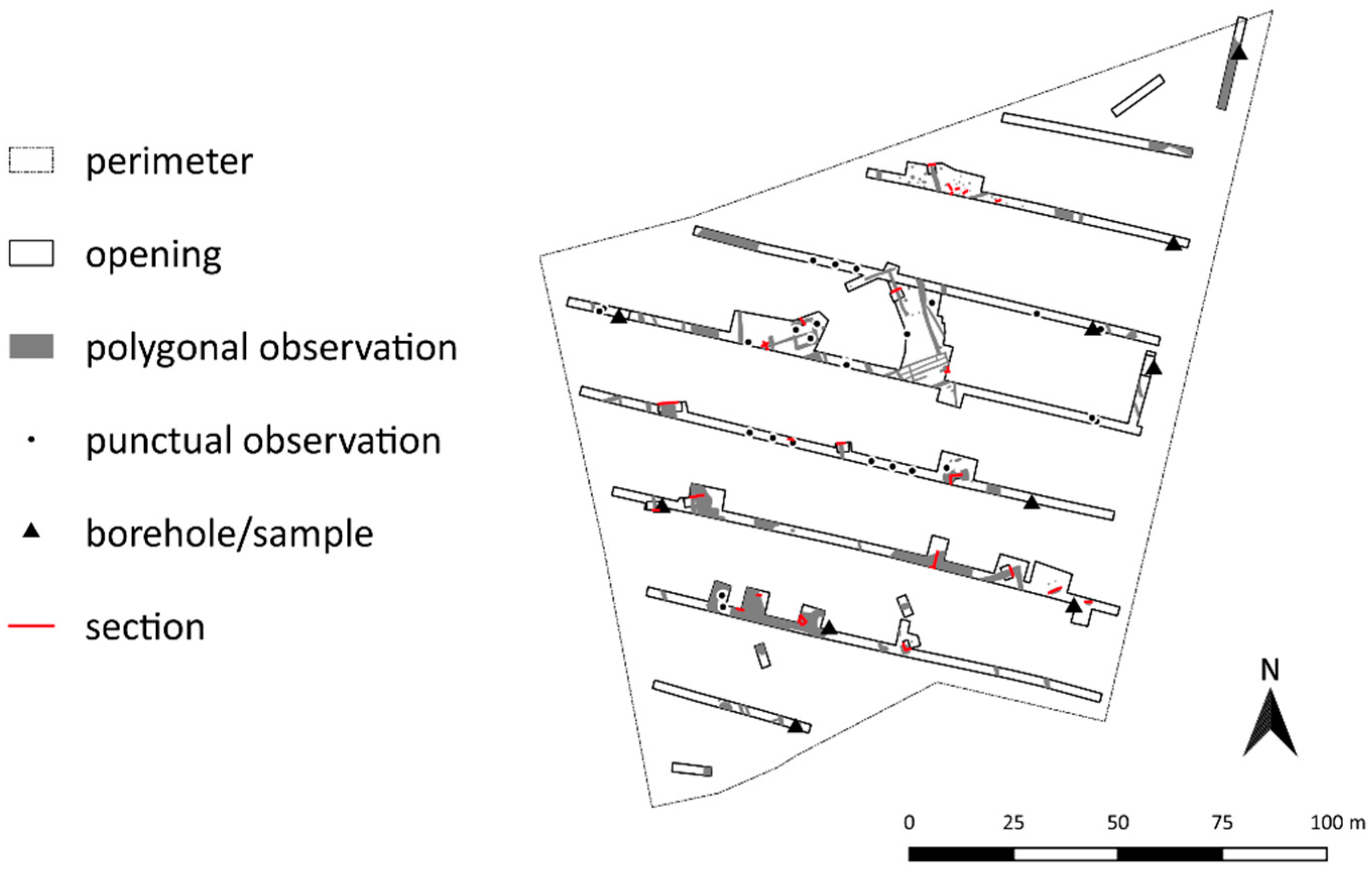
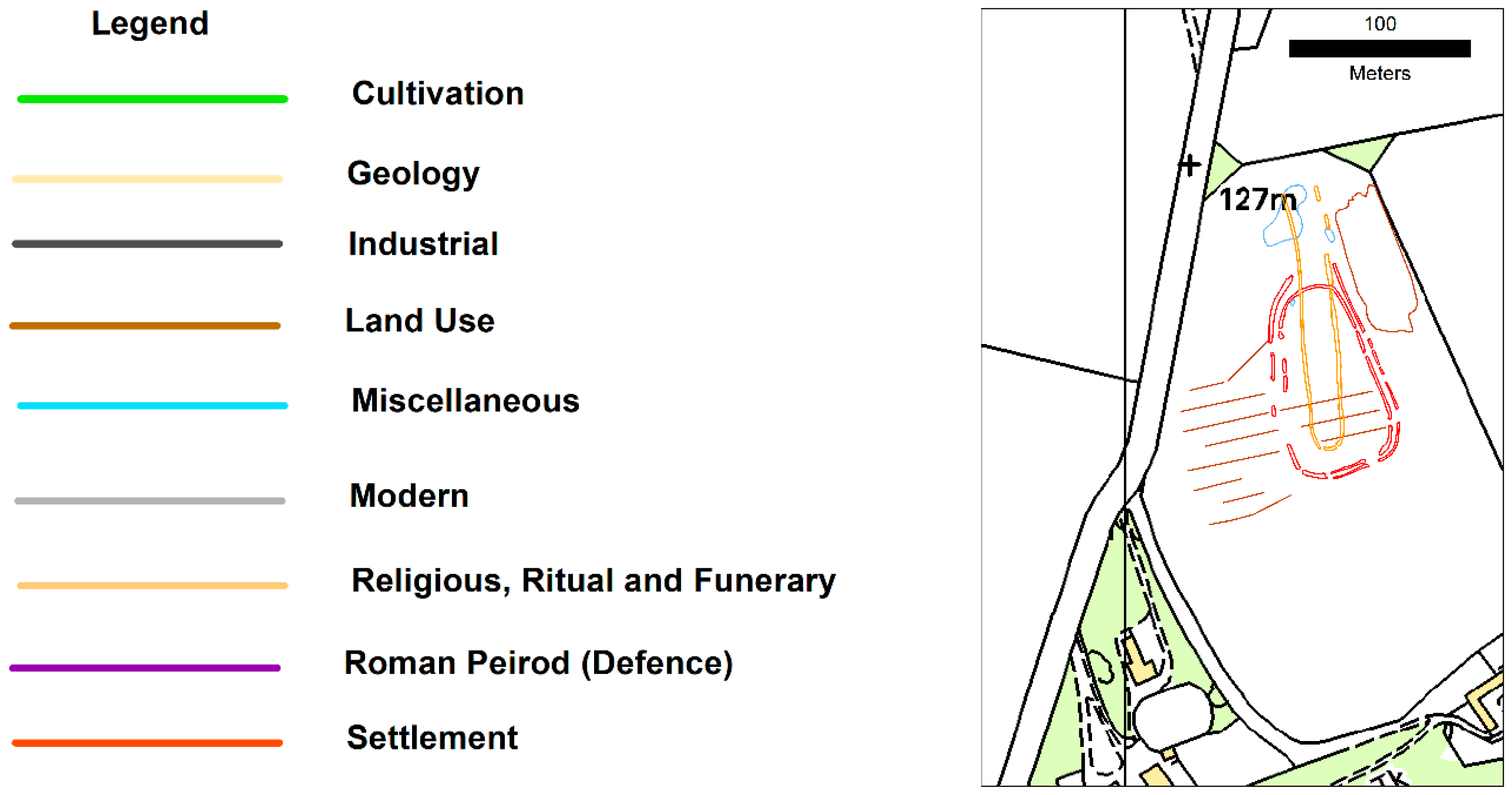
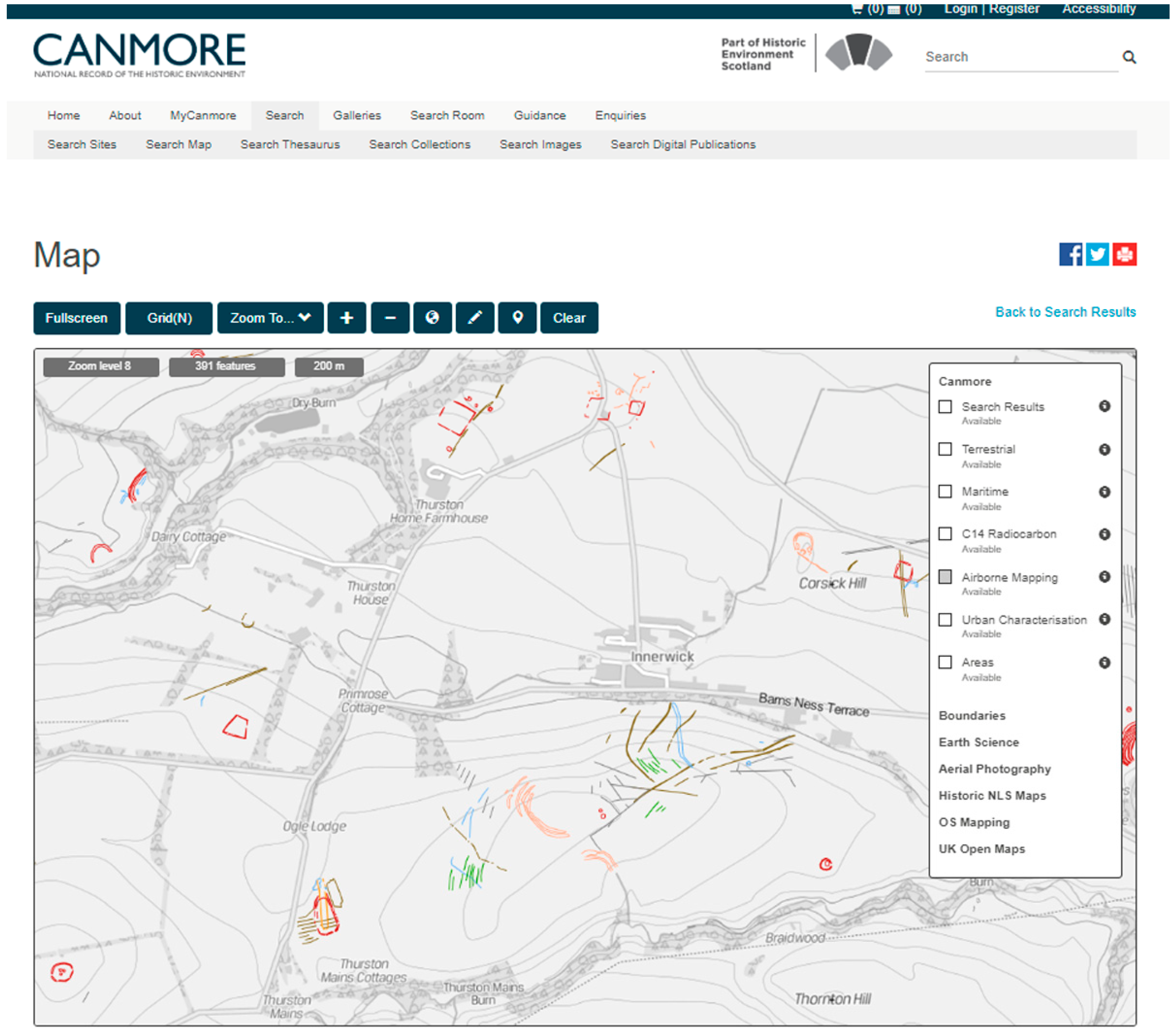
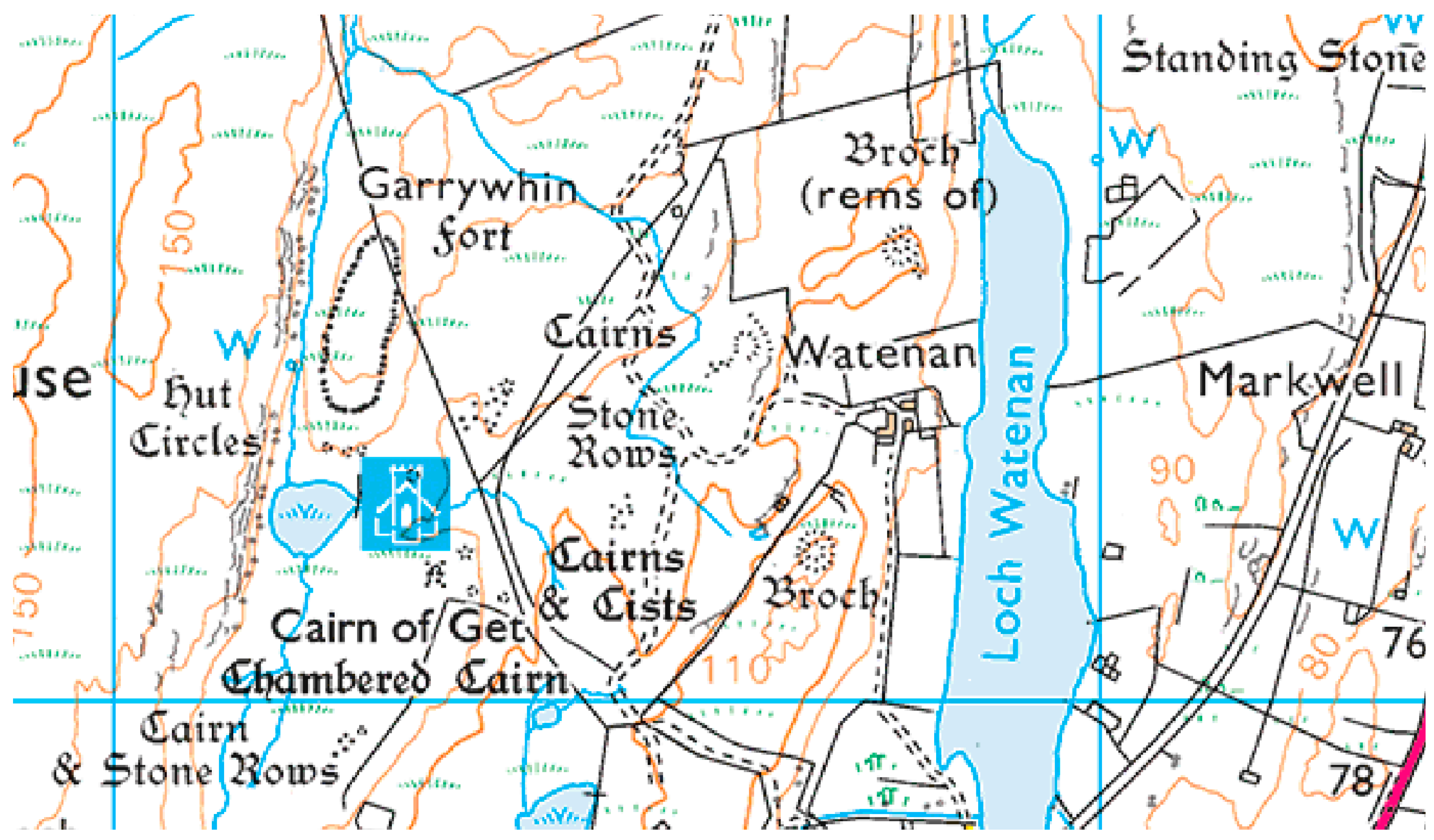
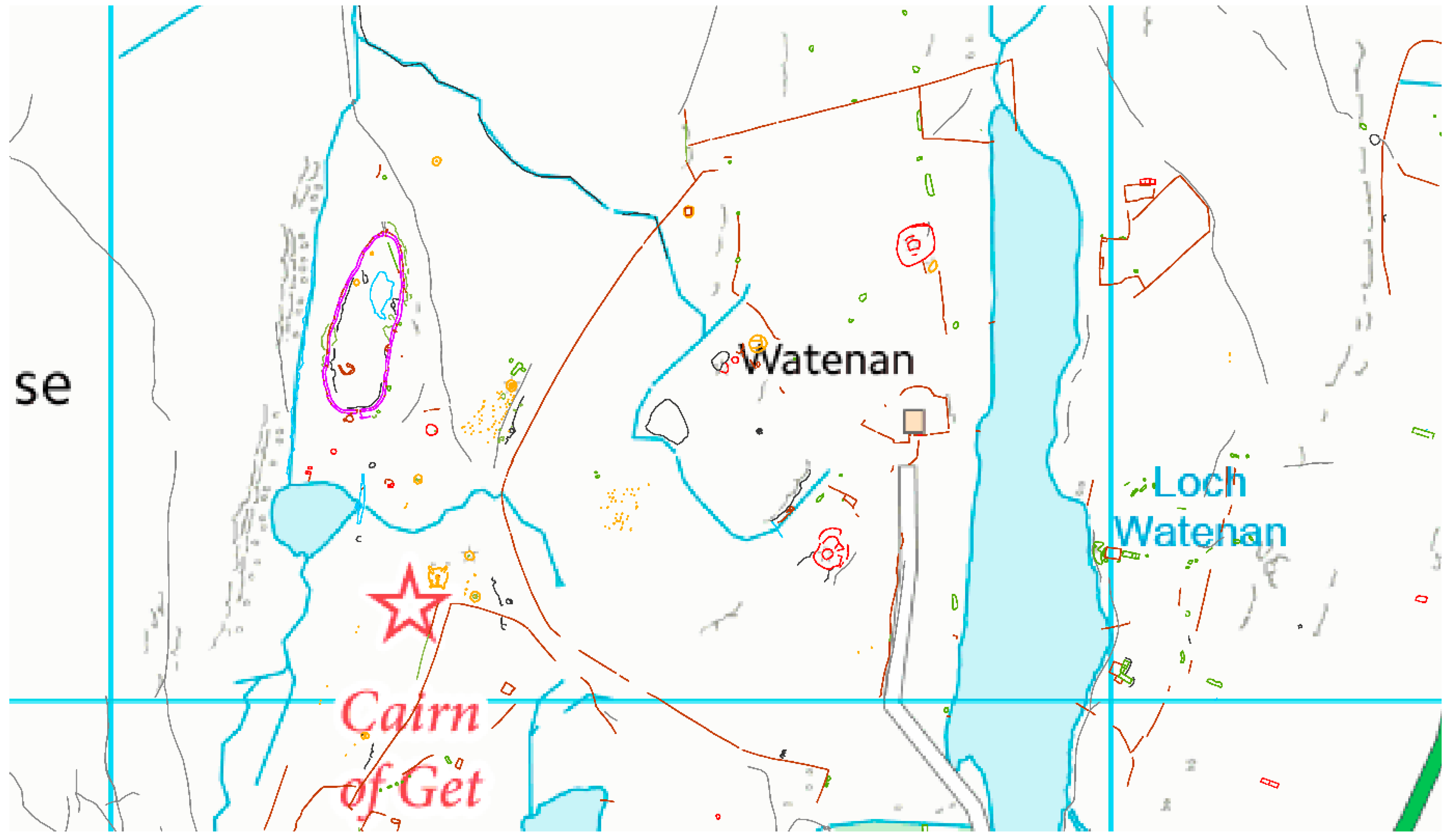
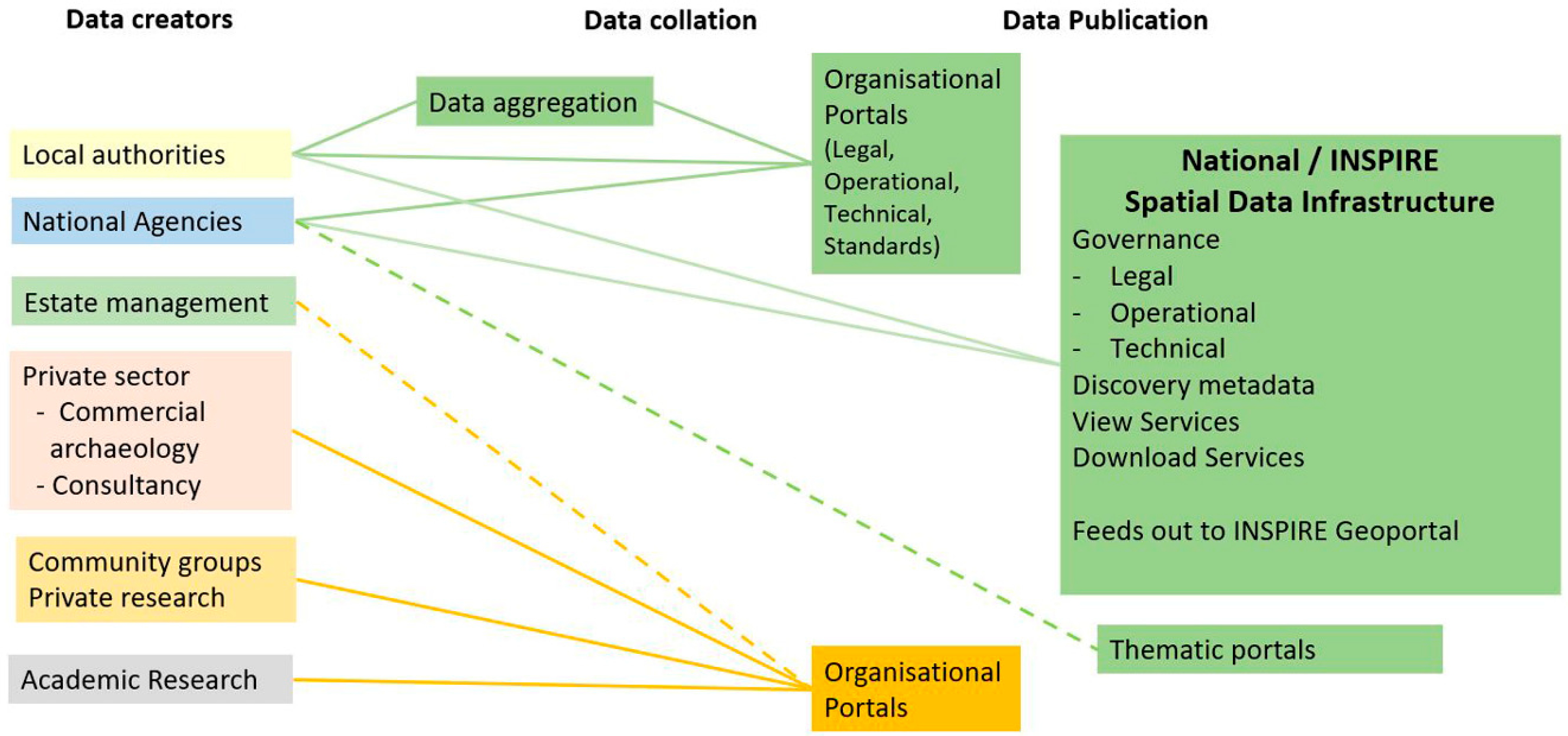
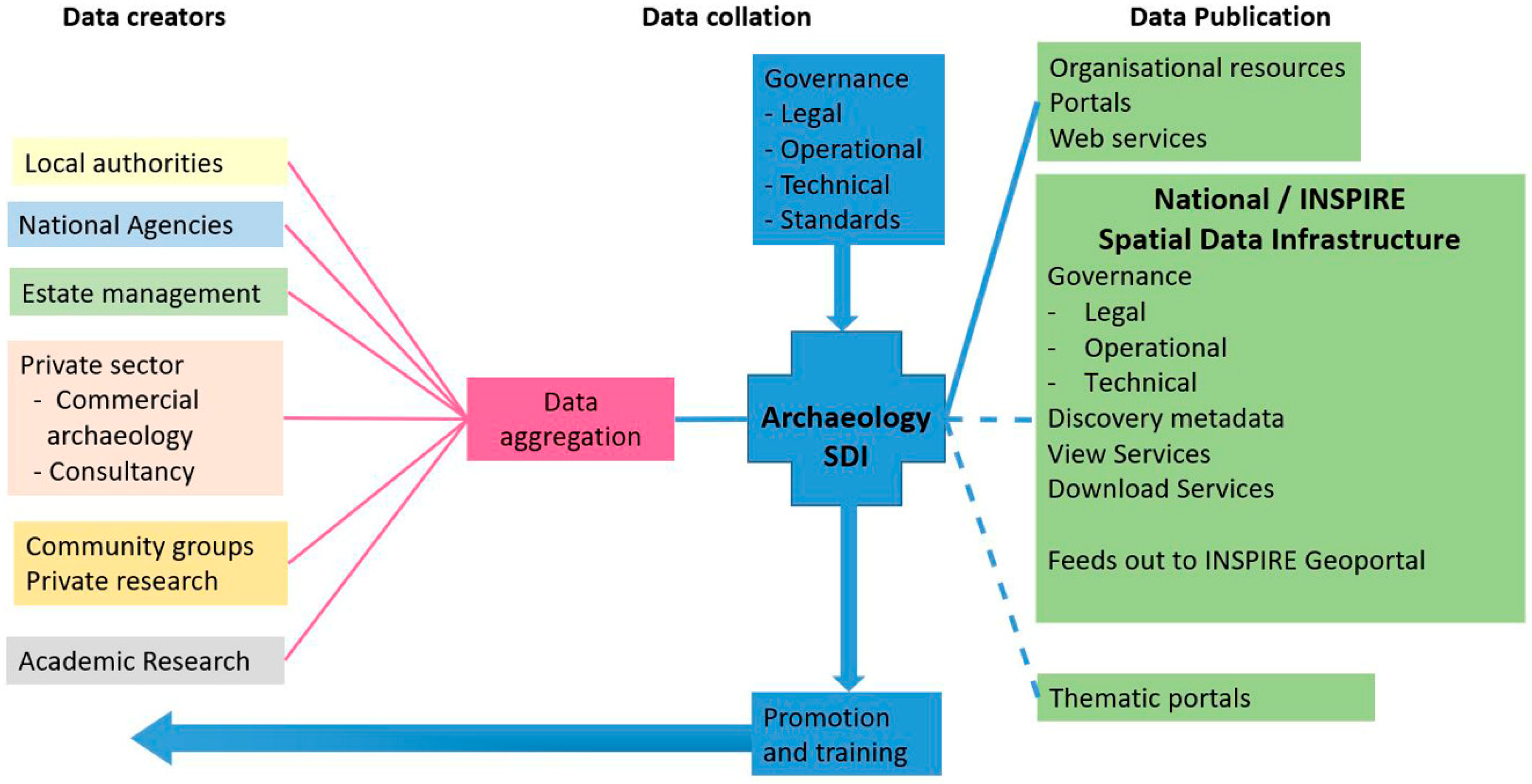
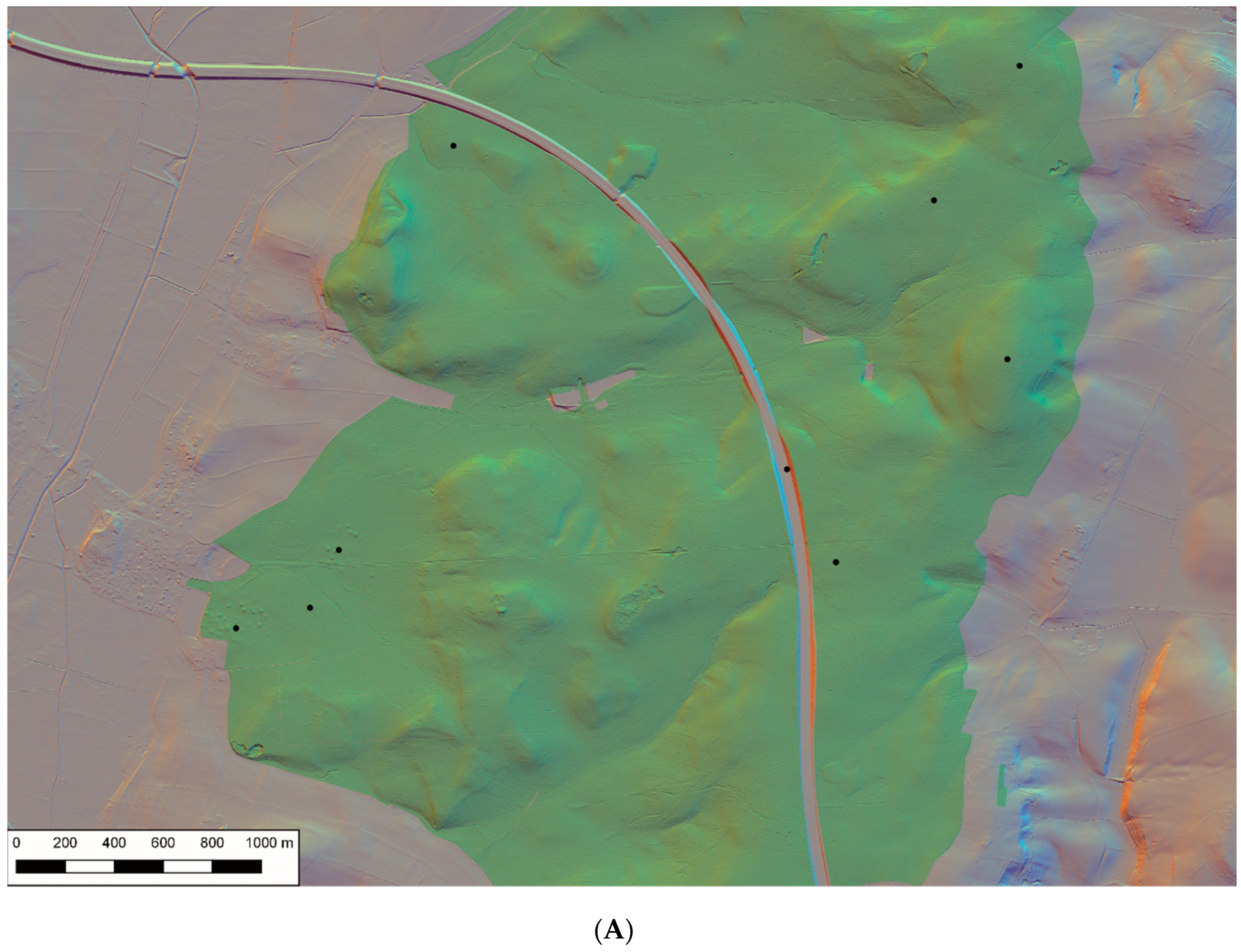
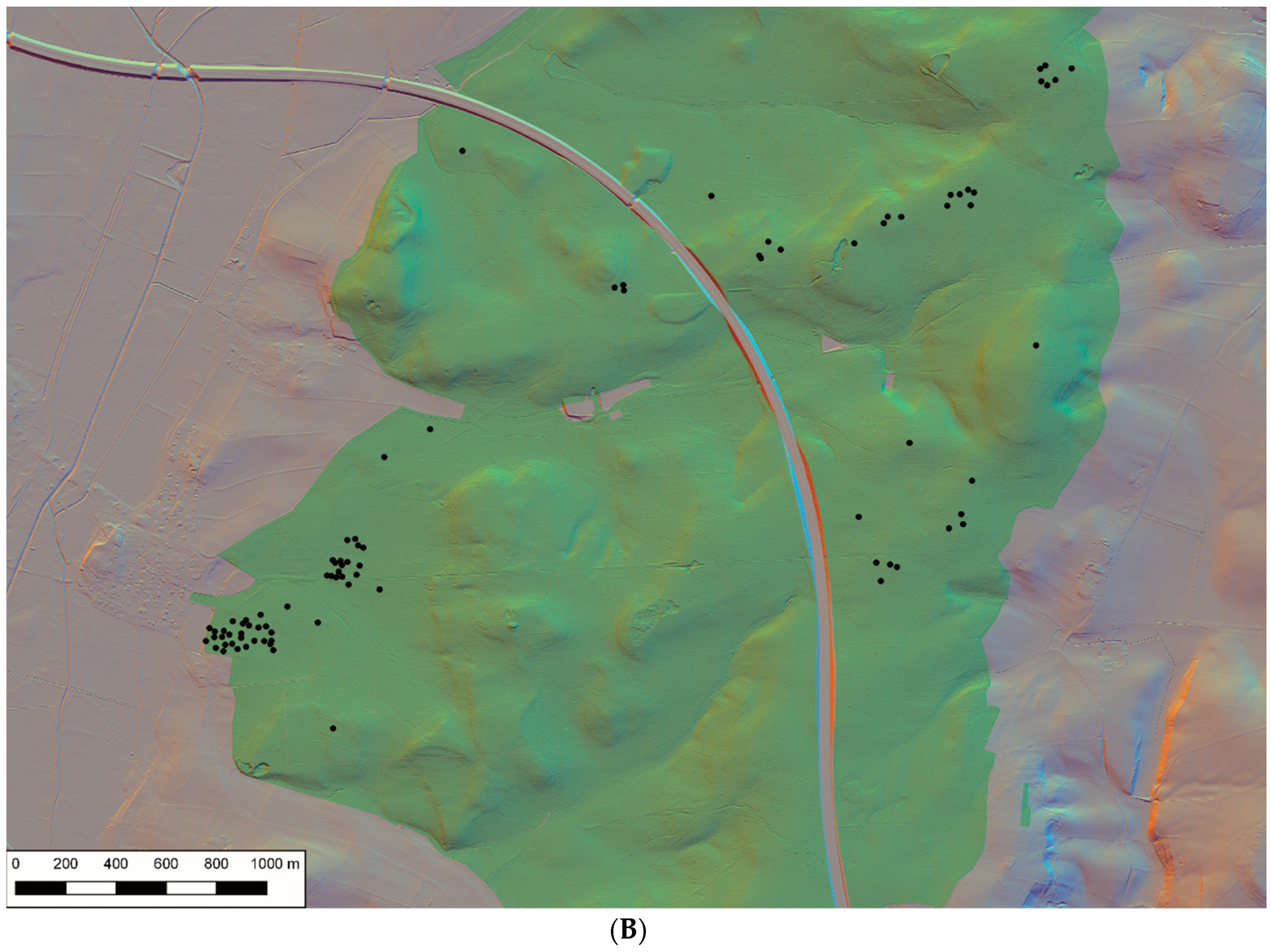
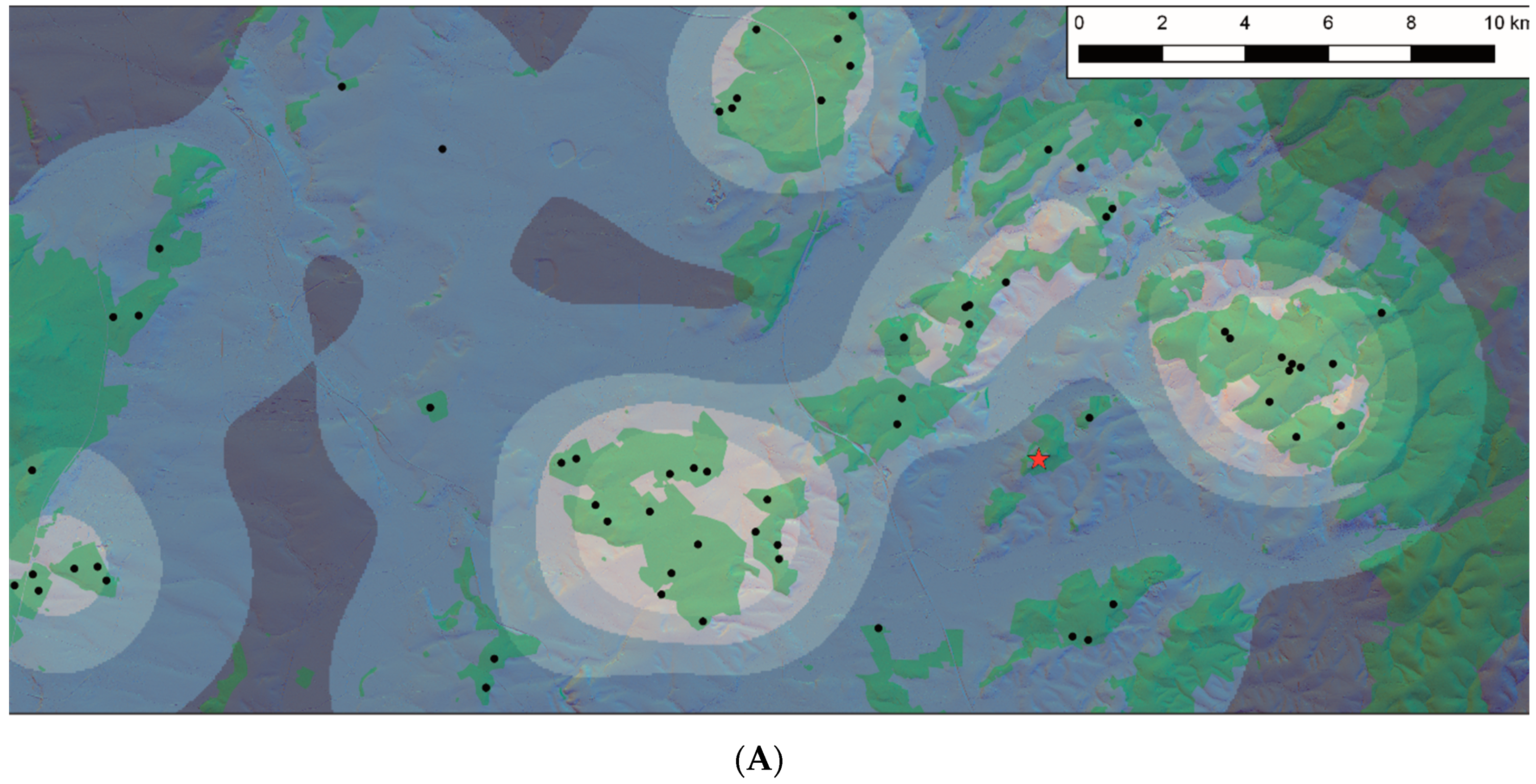
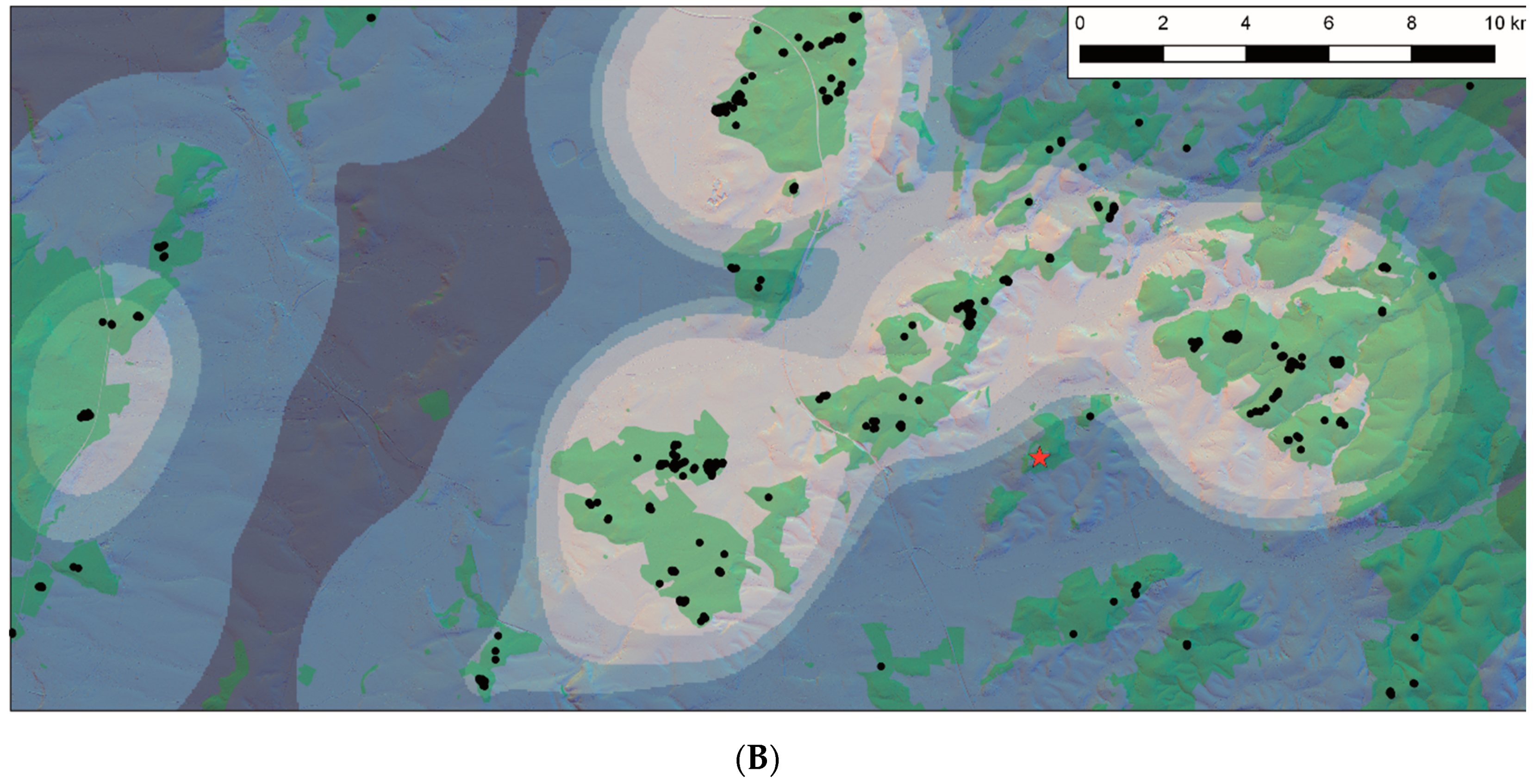
| INRAP Layer | Form | Description | |
|---|---|---|---|
| Minimum requirement for Planning purposes | Perimeter | Polygon | Defines the full extent of the area to be investigated |
| Opening | Polygon | Defines the actual extents of excavation trenches, test pits | |
| Additional archaeological documentation | Polygonal observations | Polygon | The location and extents of features recorded during excavation |
| Punctual observations | Point | The location of archaeological remains and find spots | |
| Samples | Point | The locations of samples and geomorphological observations | |
| Sections | Line | Location of sections |
| Output | Preferred Format | Purpose |
|---|---|---|
| Survey extent | Vector Polygon | Extent of survey grids |
| Grey-scale raster plots | Raster grid data and associated images surrogates | May include both the unfiltered and filtered rendering of the survey data |
| Geophysical interpretation | Vector polygon and line features | Analysis of survey results highlighting the interpretation of geophysical anomalies |
| Archaeological interpretation | Vector polygon and line features | Archaeological interpretation of the geophysical anomalies |
| Minimum metadata required to document a survey | Title | Name of survey |
| Brief description | Brief description of survey | |
| Sensor | 20mm | |
| Platform | Fixed-wing aircraft; Drone | |
| Point Density per metre(Resolution) | Minimum number of points per metre | |
| Capture Date | Date survey flown | |
| Licence | Copyright statement and terms for reuse | |
| Originator | Who undertook the survey | |
| Custodian | Place of deposit | |
| Additional paradata required by Doneus and Briese [73] | Purpose | Topography; Archaeology Planning condition |
| Scanner type | Conventional; Full-Waveform | |
| Scan Angle(Whole field of view) | Value, e.g., 15° | |
| Flying Height above Ground | 1100m; | |
| Speed of aircraft | 65 m/s 36 m/s | |
| Laser Pulse Rate | 77.500 Hz 100.000 Hz | |
| Scan Rate | 60 Hz | |
| Strip Adjustment | Yes | |
| Filtering | Robust Interpolation (SCOP++) |
© 2020 by the authors. Licensee MDPI, Basel, Switzerland. This article is an open access article distributed under the terms and conditions of the Creative Commons Attribution (CC BY) license (http://creativecommons.org/licenses/by/4.0/).
Share and Cite
McKeague, P.; Corns, A.; Larsson, Å.; Moreau, A.; Posluschny, A.; Van Daele, K.; Evans, T. One Archaeology: A Manifesto for the Systematic and Effective Use of Mapped Data from Archaeological Fieldwork and Research. Information 2020, 11, 222. https://doi.org/10.3390/info11040222
McKeague P, Corns A, Larsson Å, Moreau A, Posluschny A, Van Daele K, Evans T. One Archaeology: A Manifesto for the Systematic and Effective Use of Mapped Data from Archaeological Fieldwork and Research. Information. 2020; 11(4):222. https://doi.org/10.3390/info11040222
Chicago/Turabian StyleMcKeague, Peter, Anthony Corns, Åsa Larsson, Anne Moreau, Axel Posluschny, Koen Van Daele, and Tim Evans. 2020. "One Archaeology: A Manifesto for the Systematic and Effective Use of Mapped Data from Archaeological Fieldwork and Research" Information 11, no. 4: 222. https://doi.org/10.3390/info11040222
APA StyleMcKeague, P., Corns, A., Larsson, Å., Moreau, A., Posluschny, A., Van Daele, K., & Evans, T. (2020). One Archaeology: A Manifesto for the Systematic and Effective Use of Mapped Data from Archaeological Fieldwork and Research. Information, 11(4), 222. https://doi.org/10.3390/info11040222





